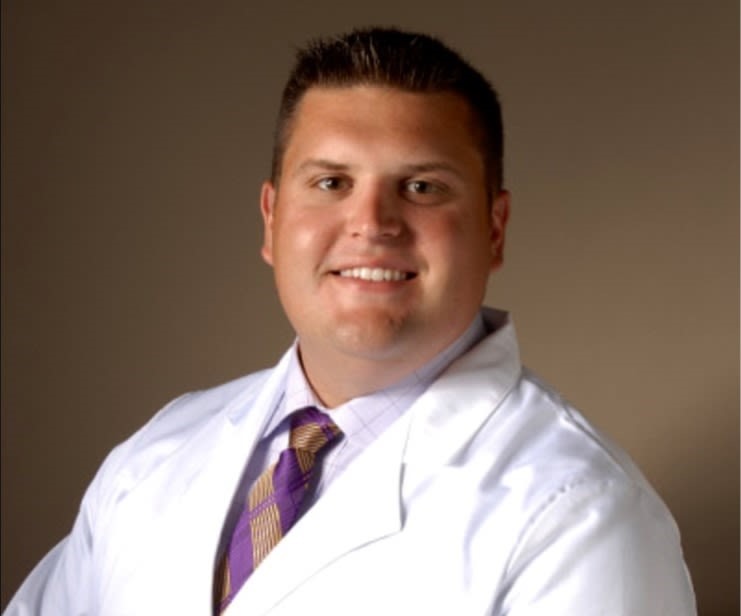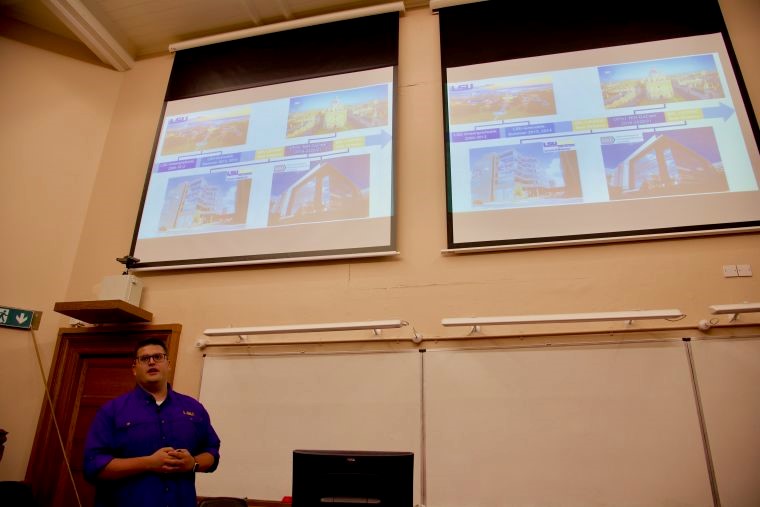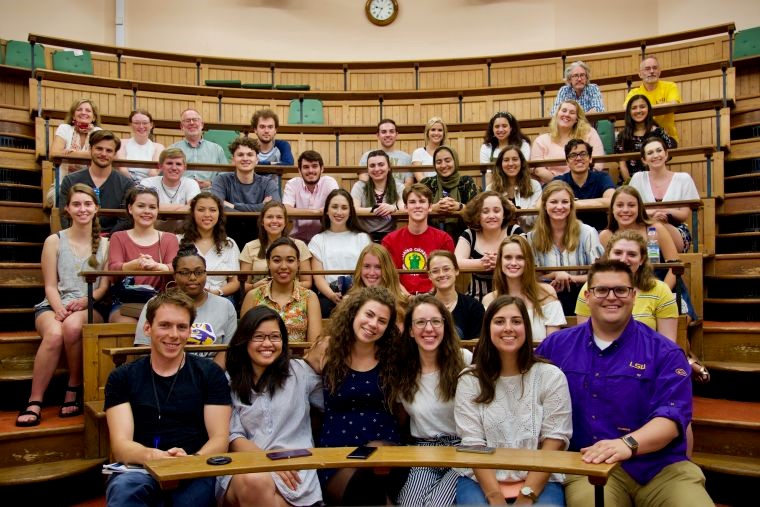NIH-OxCam-Graduate Student Stewart Humble’s Journey to Oxford
Talitha Smith
Communications Officer, University of Oxford
Department of Physiology, Anatomy, and Genetics
Reprinted with permission
https://www.dpag.ox.ac.uk/news/nih-oxcam-a-graduate-students-journey-to-oxford
 Stewart Humble was not always on the path to becoming a Research Scientist. Having completed his undergraduate education at Louisiana State University (LSU) in Baton Rouge, in his native US state of Louisiana, he entered medical school at LSU Health Science Center New Orleans in 2014. However, he felt something was missing, until he attended the LSU Neuroscience Grand Rounds lecture that presented a patient with epilepsy from New Orleans. “It helped me put together the piece that was missing, and for me that was doing meaningful research in the lab and being exposed to the most cutting-edge technologies. It was the first time I’d heard about translational research — bench to bedside — where research in the lab directly affects patient care.”
Stewart Humble was not always on the path to becoming a Research Scientist. Having completed his undergraduate education at Louisiana State University (LSU) in Baton Rouge, in his native US state of Louisiana, he entered medical school at LSU Health Science Center New Orleans in 2014. However, he felt something was missing, until he attended the LSU Neuroscience Grand Rounds lecture that presented a patient with epilepsy from New Orleans. “It helped me put together the piece that was missing, and for me that was doing meaningful research in the lab and being exposed to the most cutting-edge technologies. It was the first time I’d heard about translational research — bench to bedside — where research in the lab directly affects patient care.”
The groundwork for this lightbulb moment had already been laid during Stewart’s undergraduate degree. Between his third and fourth year in the summer of 2011, Stewart undertook study abroad in South Africa, led by Dean Nancy Clark, to fulfil one of the tenets of LSU’s Ogden Honors College curriculum, designed to enhance students’ educational experience. He visited a small rural village where mother to child transmission of HIV was prevalent. “It’s completely preventable, and while the trip wasn’t primarily science oriented, it was a transformative experience because it helped to solidify in my mind the direction I wanted to go. The idea of becoming a Physician-Scientist hadn’t really struck me yet, but I was able to strengthen my passion to go into biomedicine.”
Four years later, after solidifying his desire to return to research at that catalyst neuroscience lecture, Stewart set to work looking into this career path. He came across the NIH OxCam programme, a doctoral training programme with an opportunity for medical students to continue their education in biomedical research at either Oxford or Cambridge University in partnership with the National Institutes of Health (NIH) in Washington DC. He applied as a second-year medical student and was delighted to be accepted to study at Oxford, setting to work finding mentors at both institutions. His key aim was to combine his interests in neuroscience and translational research, and was eventually connected to his current NIH mentor, Michael E. Ward, who studies Frontotemporal Dementia (FTD) and Amyotrophic Lateral Sclerosis (ALS). “FTD is a cortical disease, ALS is a motor neuron disease, which are very different on the surface but share genetic causes. It’s a disease spectrum that we’re learning more and more about every day.”
Next, it was time to identify his Oxford mentor. Stewart first met Richard Wade-Martins of the Department of Physiology, Anatomy & Genetics when he was giving a talk at NIH. “He was very receptive to what we were interested in. Richard runs mainly a Parkinson’s Lab, so I was very lucky that he went out on a limb and was willing to support a student primarily studying FTD/ALS at the time.” It was the beginning of a key research discovery for Stewart, Michael, and Richard.
FTD and ALS occur in different subpopulations of neurons in the body and have very different clinical presentations — FTD causes a vast change in behaviour, while ALS causes a gradual loss of voluntary muscle movement. At their basis, however, the same genes are implicated as causes for inherited forms of either disorder. The basis of Stewart’s project is “knowing that these diseases share causes, we can begin to derive and search for converging disease mechanisms. If we know that gene 1 and gene 2 cause disease, then how do gene 1 and gene 2 relate to one another on a more basic level? In order to pursue the translational side and make successful therapies, we have to understand more about the basic mechanisms of some of these genes.” Stewart also examines gene-drug interactions using the cutting-edge technologies propagated by leading world scientist, Jennifer Doudna, who came to DPAG in June 2019 to discuss CRISPR cas9 gene editing, a talk Stewart attended. Furthermore, as part of the Wade-Martins Lab’s remit, Stewart investigates the genetic causes of Parkinson’s too.
Progressing through his first and second year in the programme, he and his mentors began to realise they were looking at very similar phenotypes — similar biological processes and mechanisms. “So without even realising it, we had found these underlying connections that wouldn’t have existed if Michael and I didn’t connect with Richard. It’s a key tenet of NIH-OxCam — you build relationships over the Atlantic that end up lasting well beyond your time as a student. If you put two world-leading researchers together and have a student between them, some cool things can spin off.” Stewart fondly recalls the annual NIH-OxCam dinner at Keble College at the end of June. “When we sat down to eat, I watched people get up and give speeches, and I could see 10–20 years’ worth of relationships spoken about.”
 For our students, it was an eye-opening opportunity to see how an LSU undergraduate like Stewart has pursued his academic interests across the globe.
For our students, it was an eye-opening opportunity to see how an LSU undergraduate like Stewart has pursued his academic interests across the globe.
(Left) Stewart began with a talk on Induced Pluripotent Stem Cells or iPSCs (used to make neurons and study neurodegenerative disorders).
Having spent a year in Richard’s lab and at a pivotal time in his research career, Stewart realised he wanted to give something back to the community who first educated him. Two LSU Honors College programmes were running this summer in the UK. One of Stewart’s previous LSU mentors, Drew Lamonica Arms, DPhil., oversaw the Ogden Honors in Oxford study abroad programme which focused on studying Victorian England and the Classics alongside Dr Rex Stem, both of whom studied at Oxford themselves. LSU Biological Sciences Faculty Professor Dr Vince J. Licata oversaw the London/Edinburgh programme covering the history and practical aspects of biological sciences. Stewart saw an opportunity to invite them along to the lab: “They were from my home state, all from towns 5, 10, 30 minutes from my house. The culture where I’m from is very unique. There’s a region in southwest Louisiana called Acadiana where the Cajuns live. The Cajuns are descendants of French immigrants that settled in Nova Scotia, eventually being forced to leave and then settled along the bayous and prairies in south Louisiana. There’s a huge bond between people there. You may have never met someone before, but if you’re from the same area, the two of you have this instant connection.”
Stewart had a great deal of experience in outreach and community service at LSU, including recognition as an LSU Distinguished Communicator, Ogden Honors Service Projects, and conducting chemistry demonstrations for students ranging from Kindergarten to grade 12. He also remembered his time in South Africa as a STEM undergraduate trying to identify potential research or medical careers, but working alongside mostly Social Sciences students, which exposed him to different subject areas. He believed there would be great value in bringing both LSU groups to the Wade-Martins lab, even for those who were not pursuing a science degree. “My medical school colleagues have a diverse background — history, engineering, social science majors — not only biology or pre-med students. For example, when we were going through the cardiovascular system, some of the smartest people in the room were engineers who understood flow rates and fluid dynamics. Even if you’re not a life sciences student, you never know what’s going to happen in the future, and maybe there’s a spark that gets you interested in medicine. And honestly, medicine and science in general needs to recruit people from all different kinds of backgrounds. There was a mixture of backgrounds in the LSU group as well, so even if some of the students were not focused on life sciences, I felt like there was an opportunity for them to gain an appreciation for what we do, and leave the day understanding a little more about neurodegenerative diseases and Parkinson’s, and maybe there would even be a few students who might get that spark and want to pursue science.”
The two LSU groups came together for a day at the Oxford Parkinson’s Disease Centre (OPDC). Including Stewart, six DPhil students from the lab volunteered to give presentations about their projects, followed by a guided tour of the facility and cutting-edge lab equipment. Stewart began with a talk on Induced Pluripotent Stem Cells or iPSCs (used to make neurons and study neurodegenerative disorders). He brought out his first honors college class paper from 2008 referencing Shinya Yamanaka’s discovery of taking a human skin cell (a fibroblast) and re-programming it to become an iPSC. “Who knew that 10 years later, this would pretty much be my life — I study and use iPSCs every day.” The subsequent talks ranged from an overview of Parkinson’s to RNA sequencing, as well as organoids, highlighting the diverse range of science taking place in the OPDC by a team of international researchers and students. The DPhil presenters were Kaitlyn Cramb from Canada, Quyen Do from Vietnam, Peter Kilfeather from the UK, Marta Madureira from Portugal, and Maria Claudia Caiazza from Italy. Other members of the lab hail from Spain, Germany, Lithuania, Poland, Australia, Singapore, Malaysia, Taiwan, Peru, and Ecuador.
The visit yielded a strong impact on the LSU groups. According to Drew Lamonica Arms, “Stewart and his lab partners generously gave of their time and shared their journeys to DPhil, which our students found very engaging and relatable. For our students, it was an eye-opening opportunity to see how an LSU undergraduate like Stewart has pursued his academic interests across the globe.” This encapsulates a key message for Stewart: if you can think broadly and seek out those opportunities that will advance your personal and professional goals, then there is no end to the possibilities ahead of you.

Front Row L-R: Peter Kilfeather, Quyen Do, Kailyn Cramb, Maria Claudia Caiazza,
Marta Madureira and Stewart Humble. Behind them are the two LSU Honors
College groups: Ogden Honors in Oxford and the London/Edinburgh programme.

 myLSUHSC
myLSUHSC